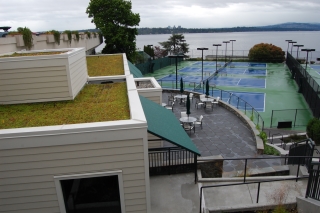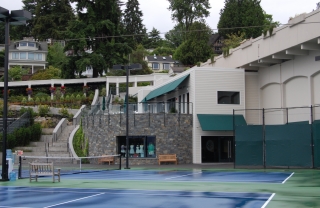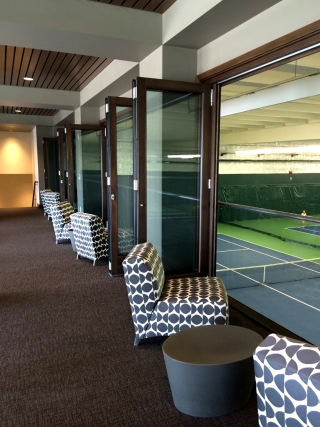|
Subscribe / Renew |
|
|
Contact Us |
|
| ► Subscribe to our Free Weekly Newsletter | |
| home | Welcome, sign in or click here to subscribe. | login |
Construction
| |

July 17, 2014
$7M rehab of Seattle Tennis Club wasn't a big job, but it sure was complicated
Journal Staff Reporter
A $6.95 million renovation at the Seattle Tennis Club wasn't large, but it shared all the elements of a full-scale commercial project, according to the contractor.
Grant Howard, project manager at Lease Crutcher Lewis, said the project involved new construction, work on a steep slope, utilities relocation, installation of a bulkhead on Lake Washington and shoreline restoration work.
Seattle Tennis Club is built into the hillside below McGilvra Boulevard East on an 8-acre property in the Madison Park neighborhood. At the bottom of the slope are the club's 13 outdoor courts, spread out alongside the lake.
Construction began last August after the Washington State Open Tennis Tournament and was completed in May, in time for the club's busy summer season.
The tight construction window was due in part to the club's proximity to the lake, where erosion and fish habitat concerns come into play. A number of agencies had to sign off on permits, including Washington State Fisheries and the U.S. Army Corps of Engineers.
During the renovation the pro shop was replaced, the indoor-court building received upgrades and a lawn area at the north end of the property was improved.
Daniel Clancy is the club's committee chair and a project consultant who worked on visioning and value engineering.
He said the renovation had been in the works for at least four years. The 124-year-old club, which has more than 3,000 members, wanted to improve its outdated facilities, reduce energy use, enhance the shoreline and make some of its areas more accessible.
Before, a visitor in a wheelchair had to detour into the main clubhouse to reach the tennis courts at the bottom of the slope. An even more circuitous route was required to get to the indoor courts. Now, a ramp descends from the clubhouse drop-off area to the new pro shop's upper entry, where a three-stop elevator can take passengers to court level.
The two-story, 4,900-square-foot pro shop is adjacent to the indoor-court building. It's more than twice the size of the single-story pro shop it replaced. The new building also houses a lobby, coffee bar, viewing areas for the indoor courts, offices, restrooms, and a spacious rooftop terrace that overlooks eight of the 13 outdoor courts.
The building was fitted with a high-efficiency HVAC fan-coil unit.
Slope work involved installing soldier piles and lagging walls. Building-information modeling was used to coordinate the construction and attend to grading and structural details.
The parking deck atop the indoor-court building was resurfaced, and the building received new insulation and waterproofing.
Michael Whalen was the architect and the Berger Partnership was the landscape architect. Perbix Bykonen was the structural engineer and Bush, Roed & Hitchings was the civil engineer.
The pro shop was designed to fit the unusual site and stands in contrast to the boxy, utilitarian building it replaced.
Each level is accessible from a curving stairway that leads down the 30-foot grade from the parking deck atop the indoor-court building.
The north portion has traditional painted lap siding and dark green awnings, similar to the original clubhouse building. Green roofs on top of the pro shop manage stormwater and help to visually link the building to the landscaped hillside.
The curving shape and rough-cut ashlar stone veneer exterior wall tie the south portion of the building to the landscape. Plants and permeable pavers help guide visitors out to the north lawn.
The wide stairway and landings include a variety of smaller garden spaces with seat walls and native plants. The spaces give visitors room to stop and socialize as they pass through.
Clancy said the new layout is a vast improvement over the old switchback stairs, which were less direct and needed new landscaping.
“It was like walking through a jungle to get down there,” he said of the former setup.
Stormwater management plays a large role in the project. The contractor, landscape architect, and civil and structural engineers worked together to address the steep topography of the site.
Rainwater is filtered through the green roofs, while rain that falls on the second-floor terrace is directed to a series of bioretention planters. A catch basin at the bottom of the slope handles stormwater before it's released into Lake Washington.
The north lawn renovation involved extensive site improvements. Once separated from Lake Washington by a steep riprap revetment and deteriorating bulkhead, the north lawn now has a restored shoreline designed to improve salmon habitat and a 290-foot bulkhead to prevent erosion and improve water quality.
Underwater debris and remnant concrete rubble were removed and replaced with salmon spawning cobble.
The 10,000-square-foot north lawn provides space for large gatherings such as weddings, reunions or parties. A sidewalk now wraps around the site and leads through a series of landscaped “outdoor rooms” with Adirondack chairs facing Mount Rainier.
A 75-foot-long trellis was added to define the north edge of the lawn from a pickleball court and a 400-square-foot garden maintenance building that was renovated with restrooms.
Lewis used two of the tennis courts for construction staging, and turned a pathway along the indoor courts into a road for bringing construction equipment in and out.
Howard, the project manager, said the biggest challenge was completing the work while the club remained open.
Additional project consultants were Warren Co., owner's representative; JRS Engineering, exterior envelope; M. Jenkins Interior Design; Shannon & Wilson, pro shop geotechnical engineer; and GeoEngineers, north lawn geotechnical engineer.
Subcontractors for Lewis were Fruhling, sitework; By Design Rockeries & Excavation, bulkhead; Teufel Landscape; Sequoyah Electric; and Bellevue Mechanical.
Jon Silver can be
reached by email or by phone
at (206) 622-8272.
Previous columns:
- Dan Peyovich has risen rapidly at HSW by embracing technology and teamwork, 07-10-2014
- Oregon couple builds a new kind of farm that uses fish to help grow vegetables, 07-03-2014
- Veterans find camaraderie in carpentry, 06-26-2014
- New company puts reclaimed wood on the table, 06-19-2014
- Starting July 1, Seattle construction and demolition projects will need waste diversion plans, 06-12-2014
- Investigators say contractor's dirt pile likely caused Delaware bridge to tilt, 06-05-2014
- Beason follows in her mother's footsteps — in construction, 05-29-2014
- WSU prof makes asphalt from old cooking oil, 05-22-2014





